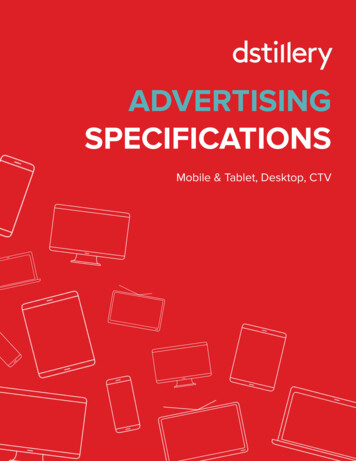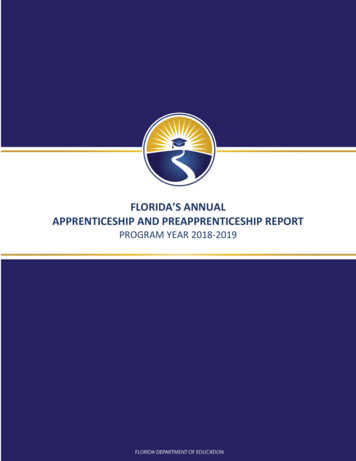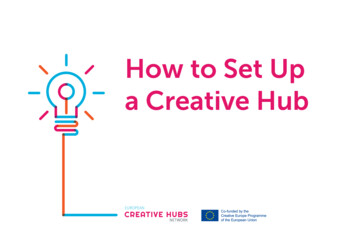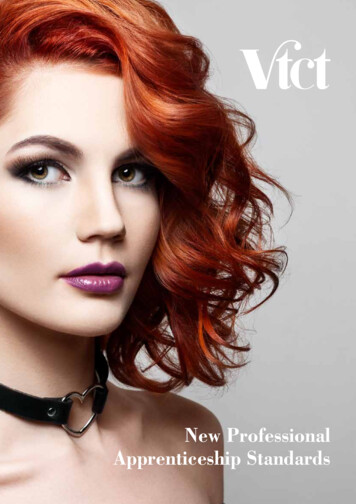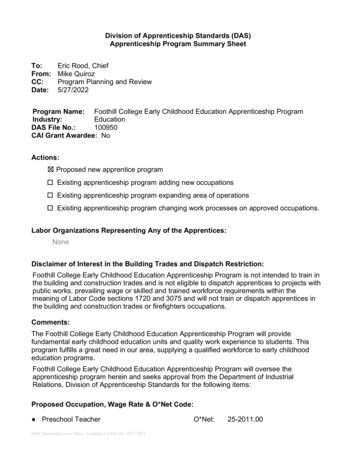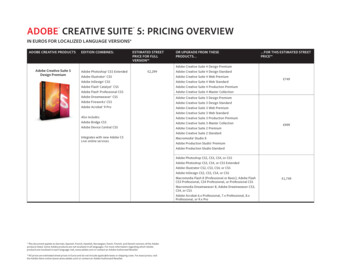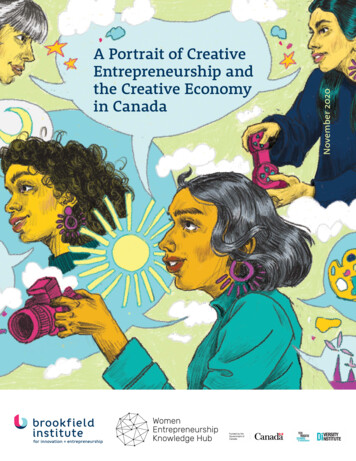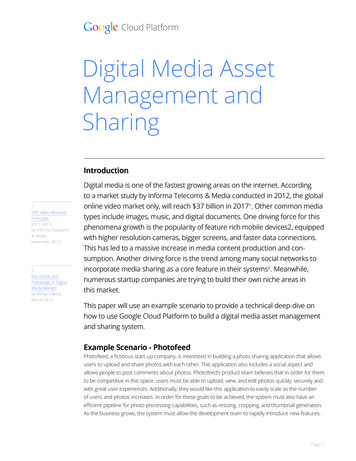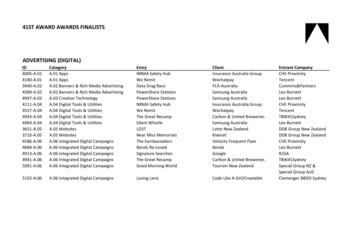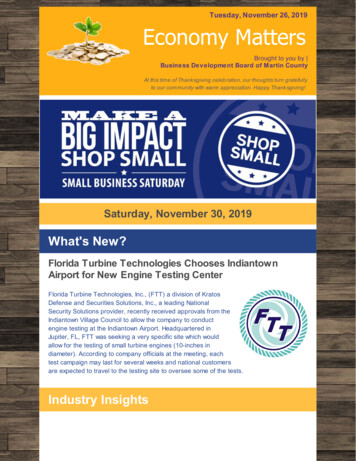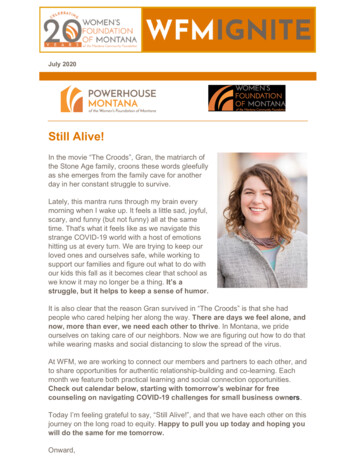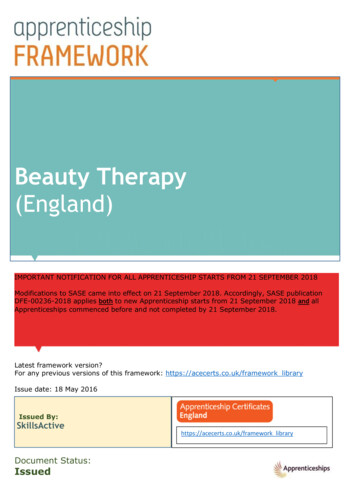
Transcription
Beauty Therapy(England)IMPORTANT NOTIFICATION FOR ALL APPRENTICESHIP STARTS FROM 21 SEPTEMBER 2018Modifications to SASE came into effect on 21 September 2018. Accordingly, SASE publicationDFE-00236-2018 applies both to new Apprenticeship starts from 21 September 2018 and allApprenticeships commenced before and not completed by 21 September 2018.Latest framework version?For any previous versions of this framework: https://acecerts.co.uk/framework libraryIssue date: 18 May 2016Issued By:SkillsActiveDocument Status:Issuedhttps://acecerts.co.uk/framework library
Beauty TherapyContentsFramework information . 7Information on the Issuing Authority for this framework: . 7SkillsActive . 7Short description . 7Intermediate Level Apprenticeship . 7Advanced Level Apprenticeship . 7Contact information. 8Proposer of this framework. 8Revising a framework . 10Why this framework is being revised . 10Summary of changes made to this framework . 10Qualifications removed . 10Qualifications added . 10Qualifications that have been extended . 10Purpose of this framework . 11Summary of the purpose of the framework. 11National Apprenticeship Service (NAS) - Statement on Apprenticeship Quality Definition . 11Aims and objectives of this framework (England) . 12AIM . 12OBJECTIVES . 12Entry conditions for this framework . 13Level 2, Pathway 1: Beauty Therapy - General . 16Description of this pathway . 16Entry requirements for this pathway in addition to the framework entry requirements . 16Qualifications. 18Competence qualifications available to this pathway . 18Knowledge qualifications available to this pathway . 18Combined qualifications available to this pathway . 19Relationship between competence and knowledge qualifications . 19LEGAL REQUIREMENT . 19MANDATORY UNITS . 19
OPTIONAL UNITS . 20Transferable skills (England) . 21Inclusion of Information and Communications Technology (ICT) . 22Progression routes into and from this pathway . 23Employee rights and responsibilities . 24Certification Requirements for ERR . 25Level 2, Pathway 2: Beauty Therapy - Make-up . 26Description of this pathway . 26Entry requirements for this pathway in addition to the framework entry requirements . 26Qualifications. 28Competence qualifications available to this pathway . 28Knowledge qualifications available to this pathway . 28Combined qualifications available to this pathway . 29Relationship between competence and knowledge qualifications . 29LEGAL REQUIREMENT . 29MANDATORY UNITS . 29OPTIONAL UNITS . 30Transferable skills (England) . 31Inclusion of Information and Communications Technology (ICT) . 32Progression routes into and from this pathway . 33Employee rights and responsibilities . 34Certification Requirements for ERR . 35Level 3, Pathway 1: Beauty Therapy - General . 37Description of this pathway . 37Entry requirements for this pathway in addition to the framework entry requirements . 37Qualifications. 39Competence qualifications available to this pathway . 39Knowledge qualifications available to this pathway . 39Combined qualifications available to this pathway . 40Relationship between competence and knowledge qualifications. 40LEGAL REQUIREMENT . 40MANDATORY UNITS . 40OPTIONAL UNITS . 41Transferable skills (England) . 42Inclusion of Information and Communications Technology (ICT) . 43Progression routes into and from this pathway . 44Employee rights and responsibilities . 45Certification Requirements for ERR . 46Level 3, Pathway 2: Beauty Therapy - Make-up . 47Description of this pathway . 474
Entry requirements for this pathway in addition to the framework entry requirements . 47Qualifications. 49Competence qualifications available to this pathway . 49Knowledge qualifications available to this pathway . 49Combined qualifications available to this pathway . 50Relationship between competence and knowledge qualifications . 50LEGAL REQUIREMENT . 50MANDATORY UNITS . 50OPTIONAL UNITS . 51Transferable skills (England) . 52Inclusion of Information and Communications Technology (ICT) . 53Progression routes into and from this pathway . 54Employee rights and responsibilities . 55Certification Requirements for ERR . 56Level 3, Pathway 3: Beauty Therapy - Massage . 57Description of this pathway . 57Entry requirements for this pathway in addition to the framework entry requirements . 57Qualifications. 59Competence qualifications available to this pathway . 59Knowledge qualifications available to this pathway . 59Combined qualifications available to this pathway . 60Relationship between competence and knowledge qualifications . 60LEGAL REQUIREMENT . 60MANDATORY UNITS . 60OPTIONAL UNITS . 61Transferable skills (England) . 62Inclusion of Information and Communications Technology (ICT) . 63Progression routes into and from this pathway . 64Employee rights and responsibilities . 65Certification Requirements for ERR . 66How equality and diversity will be met . 67Barriers: . 67Actions: . 67On and off the job guided learning (England) . 67Total GLH for each pathway . 67Legal Requirement . 67Minimum off-the-job guided learning hours . 68Intermediate Level Apprenticeship Beauty Therapy - General . 68Beauty Therapy Make-up. 69Advanced Level Apprenticeships Beauty Therapy General . 695
Beauty Therapy Make-up. 69Beauty Therapy Massage . 69How this requirement will be met . 70Minimum on-the-job guided learning hours . 71Intermediate Level Apprenticeships Beauty Therapy General . 71Beauty Therapy Make-up. 71Advanced Level Apprenticeship Beauty Therapy General. 71Beauty Therapy Make-up. 71Beauty Therapy Massage . 72How this requirement will be met . 72Certification Requirements for GLH . 73Personal learning and thinking skills assessment and recognition (England) . 74Summary of Personal Learning and Thinking Skills . 74Certification Requirements for PLTS . 75Creative thinking . 75Independent enquiry . 75Reflective learning . 75Team working . 76Self management . 76Effective participation . 766
Framework informationInformation on the Issuing Authority for this framework:SkillsActiveThe Apprenticeship sector for occupations in sports coaching, active leisure, hairdressing and beauty(also includes fitness, stewarding, outdoors, playwork and sporting excellence).Issue number: 8Framework ID:FR03860This framework includes:Level 2 Level 3 Level 4-7 Date this framework is to be reviewedby: 31/12/2017This framework is for use in: EnglandShort descriptionThe Beauty Therapy framework provides the option for apprentices to select discretedevelopment pathways including Beauty Therapy General or Beauty Therapy Make-Up atIntermediate Level and Beauty Therapy General, Beauty Therapy Make-Up or Beauty TherapyMassage at Advanced Level.There are two levels of Apprenticeship contained in this framework:Intermediate Level ApprenticeshipA learner may work as a junior beauty therapist or skin care and make up consultant.Advanced Level ApprenticeshipA learner may work as a beauty therapist, electrolysist, masseur/masseuse or make-up artist.Careers may take place in a variety of locations including beauty salons, hospitals, care homes,cruise ships, spas and health clubs or working freelance.7
Contact informationProposer of this frameworkHabia used a wide variety of methods to engage with employers and industry during thisconsultation resulting in attracting a wide and varied audience.This included:Employer workshopsIndustry ForumsConferencesPresentationsOnline consultationA questionnaire was developed along with a toolkit to assist employers with the understandingof key terms.A number of key Employers and Industry Organisations supported the development of thisframework including:Federation of Holistic TherapistsGill Morris TrainingProfessional Cosmetic SolutionsGrafton InternationalArmoniaEllisonsDeveloper of this frameworkName:Carolynne HansonOrganisation:HabiaOrganisation Type:Standard Setting BodyJob Title:Development OfficerEmail:carolynne.hanson@habia.orgPostal address:SkillsActive/HabiaStyrrup Golf andCountry ClubMain StreetStyrrupDoncasterDN11 8NB8
Website:http://www.habia.org/Issuing Authority’s contact detailsIssued by:SkillsActiveIssuer contact name:Caroline LarisseyIssuer contact phone:033 0004 0005 / 01302774911Issuer Email:issuingauthority@skillsactive.com9
Revising a frameworkWhy this framework is being revisedThis framework has been revised to add newly accredited knowledge and competence qualifications.Summary of changes made to this frameworkThis framework has been revised to add newly accredited knowledge and competence qualifications.Qualifications removedThe following qualifications have been removed from the framework:SQA Level 2 NVQ Diploma in Beauty Therapy - General 600/3071/9SQA Level 2 NVQ Diploma in Beauty Therapy - Make-Up 600/2975/4SQA Level 3 NVQ Diploma in Beauty Therapy - General 600/2931/6SQA Level 3 NVQ Diploma in Beauty Therapy - Make-Up 600/2925/0SQA Level 3 NVQ Diploma in Beauty Therapy - Massage 600/3019/7Qualifications addedThe following qualifications have been added to the TherapyTherapyTherapyTherapyTherapy-General 601/7055/4Make-Up 601/7056/6General 601/7057/8Make-Up 601/7053/0Massage 601/7065/7Qualifications that have been extendedN/A10
Purpose of this frameworkSummary of the purpose of the frameworkNational Apprenticeship Service (NAS) - Statement on Apprenticeship Quality DefinitionAn Apprenticeship is a job with an accompanying skills development programme designed byemployers in the sector. It allows the apprentice to gain technical knowledge and real practicalexperience, along with functional and personal skills, required for their immediate job andfuture career. These are acquired through a mix of learning in the workplace, formal off the jobtraining and the opportunity to practice and embed new skills in a real work context. Thisbroader mix differentiates the Apprenticeship experience from training delivered to meetnarrowly focused job needs. All apprentices commencing their Apprenticeship on or after 6thApril 2012 must have an Apprenticeship Agreement between the employer and the apprentice.This can be used to reinforce the understanding of the requirements of the Apprenticeship.This framework provides a nationally agreed apprenticeship framework for a work basedlearning route into employment for the beauty industry, using qualifications that combine bothskills and knowledge.With an increasing number of young people staying on at school, the Intermediate LevelApprenticeship and Advanced Level Apprenticeship in Beauty Therapy provide qualityalternatives leading to the achievement of the Level 2 and/or Level 3 NVQ Diploma.In the UK there are 4,800 beauty salons, 36,000 hairdressing salons (5,800 of which offerbeauty therapy treatments particularly those which, for example, are in hotels and leisurecentres). There has been significant growth in the number of independent nail salons and spafacilities, also in the number of existing beauty therapy salons now offering an extended rangeof services including nail services and spa facilities.Prior to the development of this framework, those who wanted to work in a beauty therapy jobrole had to achieve the NVQ Diploma by attending a full time college based programme. Thisframework will allow for an alternative work based learning route to training in full timeeducation for the beauty therapy industry from Intermediate Level and a progression routefrom Level 2 full time courses to an Advanced Level Apprenticeship.Depending on the pathway followed and level achieved, learners completing an apprenticeshipwill undertake roles such as:Junior beauty therapist, manicurist or skin care and make up consultant (Intermediate Level)11
Beauty Therapist, electrolysist, masseur/masseuse or make-up artists (Advanced Level)Careers may take place in a variety of locations including beauty salons, hospitals, care homes,cruise ships, spas and health clubs or working freelance.Aims and objectives of this framework (England)AIMTo provide a nationally agreed apprenticeship framework for a work based learning route intoemployment in the industry, using qualifications that combine both skills and knowledge andare based on the latest research with employers. There are c11,000 beauty businesses inEngland, employing about 33,000 beauty therapists, plus many more freelance operators.OBJECTIVESTo provide a structured learning programme that meets the needs of employers andemployees.To provide learners with the skills needed to be a professional beauty therapist, able tooffer a wide range of treatments to clients, with a clear understanding of how theirperformance is directly related to the success of the business and their ownremuneration.To increase the level of employer involvement in training and development of their staffin readiness for a fall in the number of school leavers which will create the need torecruit from older age groups.More information about sector priorities can be found on the Habia website at www.habia.orgunder 'Reports and Statistics' and under 'Training and Skills – Sector Qualifications Strategy.'This framework will contribute to the Business, Innovation and Skills Priorities set out in theSkills for Sustainable Growth (2010) and Government's plans to reform adult learning andskills. It will specifically address:FairnessSupporting learners who have not achieved basic skills during their schooling to obtainliteracy and numeracy skills, with Key Skills or Functional Skills accreditation. This willhelp reduce the 16% of adults who do not have Level 1 literacy and numeracy skills.ResponsibilityRequiring apprentices to understand their employment rights and responsibilities and toobtain an understanding of the sector and its career pathways so they can make informedchoices about their future.FreedomProviding clear information for learners about apprenticeships as a pathway from school toemployment and higher education.12
Enabling learners to select training and qualifications valued by business and widelyavailable throughout England because this framework complies with the latestSpecification for Apprenticeship Standards in England and includes the latestqualifications from the Qualification and Credit Framework for England.Skills for GrowthProviding a comprehensive suite of apprenticeship frameworks, of which this is one,covering all the main occupations in the Hair and Beauty Sector, some with a tradition ofentry via apprenticeships, such as hairdressing, and some that do not, such as beautyand spa therapy.Contributing to the growth of apprentices to over 200,000 starts per year by 2014-15 andincreased completions. By expanding the numbers in our non-traditional apprenticeshipsectors we can contribute further to the investment by employers and individuals in skills.Supporting technician level achievement. The sector regards the Advanced Level as thesign of professional stylist, therapist, nail technician etc but this aspiration needs to bereflected in an increase in take up and completion of Advanced Level Apprenticeships.This framework is part of the comprehensive suite of pathways that will encourage thisaspiration and the wider achievement of professional standards.Entry conditions for this frameworkThere are no nationally agreed minimum entry or previous entry requirements for thisframework but the following criteria may be used as guidance.This industry has high client expectations and relies on repeat business so importance is givento:Appropriate personal presentation including clothing, hair and personal hygiene.Practical, organisational and social skills.Attention to detail and cleanliness.A good sense of humour/amicable nature and communication skills whether dealing faceto face with clients or speaking on the telephone.Willingness to work flexible hours/days as agreed in the employment contract.A high degree of dexterity and coordination.Potential apprentices with a predisposition to certain skin conditions or allergies, such asoccupational dermatitis, eczema or asthma, need to understand that some of thechemicals, liquids and aerosols used in beauty therapy may have a significant effect ontheir health.Colour blindness would restrict opportunities in the wide use of artificial colouringproducts and services in the industry. Units relating to make-up application and nail13
services require the ability to recognise tones, shades and changes in a range of colours.Apprentices must always be interviewed by their potential employer and training provider.They may deem enthusiasm and passion for the subject to be more important than formalqualifications. It is for this reason that the Hair and Beauty Sector has chosen not to be overlyprescriptive about entry requirements. The training provider and employer are advised to usea range of initial assessment techniques to identify any additional support needs for theApprentice from the start of the Apprenticeship. This will ensure that those who begin have thepotential to complete the programme.It is advantageous to have had previous experience of working within the beauty therapyindustry.Entry to the beauty therapy framework is usually at intermediate level with progressionto advanced level. In circumstances where previous qualifications or experience havebeen gained it is possible to enter at advanced level and may be preferred by someemployers.14
Level 2Title for this framework at level 2Intermediate Level Apprenticeship inBeauty TherapyPathways for the framework at level 2:Pathway 1:Beauty Therapy - GeneralPathway 2:Beauty Therapy - Make-up15
Level 2,Pathway 1: Beauty Therapy - GeneralDescription of this pathwayThis pathway develops skills to foundation level and employment as a Junior Beauty Therapist.Apprentices on the programme will achieve a minimum of 64 credits in total.54 credits for competence and knowledge - Level 2 NVQ Diploma in Beauty Therapy General10 credits Transferable skills - 5 credits for Maths and 5 credits for EnglishEntry requirements for this pathway in addition to the framework entryrequirementsThese requirements should be read in conjunction with the entry conditions which can be foundearlier in this document.Further guidance on entry requirements can be found on the Habia apprenticeships website athttp://www.habia.org/apprenticeships.It is advantageous to have three GCSEs Grade D or above in English, Maths, Science or Art.16
Job title(s)Junior Beauty TherapistJob role(s)Carrying out treatments including waxing, manicure, pedicure, facialsand make-up activities as well as assisting with spa operations.17
QualificationsCompetence qualifications available to this pathwayN/AKnowledge qualifications available to this pathwayN/A18
Combined qualifications available to this pathwa
There are two levels of Apprenticeship contained in this framework: Intermediate Level Apprenticeship A learner may work as a junior beauty therapist or skin care and make up consultant. Advanced Level Apprenticeship A learner may work as a beauty therapist, electrolysist, masseur/masseuse or make-up artist.
